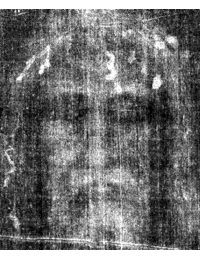
After a 10-year hiatus in public viewing, the Shroud of Turin will again go on display from April 10 to May 23 at the cathedral in Turin, Italy. The 14-foot-long, 4-foot wide, linen fabric with the image of a naked, bloody, bearded man is regarded by millions of Christians to be the burial cloth that covered the body of Jesus Christ in the tomb after his crucifixion. The image of the Man in the Shroud, they believe, was miraculously formed. Skeptics claim it is a medieval forgery, so longstanding arguments about it are certain to be raised again in the media.
During the 44 days it will be available for viewing, one million to two million people are expected to queue up to look at it. Pope Benedict XVI has scheduled a personal viewing.
To resolve the question — is it authentic or a hoax? — dozens of scientists and scholars have investigated the Shroud for decades. Only last year an Italian scientist announced that he had reproduced an image similar to the Shroud’s by using conventional means — oven heating of a painted cloth. His claim was immediately and loudly disputed by other Shroud researchers.
Where do things now stand? On the basis of both scholarly and scientific research, the Shroud of Turin appears to be genuine. Here are facts provided by scientists and scholars.
First, the provenance of the Shroud — its documented history of ownership — has now been completely established. There had been a gap of one and a half centuries, from 1204 to 1351 A.D. In 2009, the Vatican announced the discovery of a letter indicating the Knights Templar held the Shroud during that time. (That confirmed what many scholars had long thought was the case.) The discovery filled in the gap, giving an unbroken, documented history of the cloth. On that basis alone, it is enough to say with great certainty that the Shroud is not a hoax. But there is much more to support that view.
A carbon-14 test was performed on a sample of the Shroud in 1988 to determine its age. The test, widely publicized at the time, dated the Shroud between 1280 and 1430 A.D., which suggested that the Shroud was a medieval forgery. However, newer research discovered that the test used a cutting from the Shroud that is now recognized as a 16th-century “patch” or “Invisible” repair — invisible to the naked eye but seen clearly under high magnification. The repair used cotton thread, which is found nowhere else in the Shroud. Nuns had performed the repair to a section of the cloth that had been damaged in a 15th-century fire. The carbon-14 test was performed upon a sample that included both new and original threads, thus yielding the apparently medieval origin. New chemical tests on samples from the original linen move the age of the Shroud back in time to the first century A.D.
Furthermore, the weaving of the linen Shroud is now recognized as consistent with the weaving of first century Palestine, but not 14th-century Europe. New research has also identified pollen grains on the Shroud that some experts claim could only have come from the vicinity of Jerusalem during March and April — Passover time — when such vegetation is in bloom.
For these and other research-based reasons, the cloth is said to be clearly established as an authentic first-century relic from the Near East.
As for the image of the Man in the Shroud, research likewise indicates it is no hoax. The blood stains are real (type AB) and contain human male DNA. The man was about 5’ 11” and weighed about 170 pounds. The Shroud of Turin Research Project (STURP), a group of scientists who began researching the Shroud in 1976, stated in its report: “The actual image was created by a phenomenon (as yet unknown) or a momentous event that caused … a sepia or straw-yellow colored image similar to that of a scorch.” Moreover, the image was formed only on the topmost fibrils of the surface fibers touching the body or close to it; the scorch does not go below the surface of the cloth.
Shroud researcher Frank Tribbe notes in his recent book Portrait of Jesus? that the closest science can come to explaining how the image got there is by comparing the situation to a controlled burst of high-intensity radiation similar to the Hiroshima A-bomb explosion that “printed” images of incinerated people on building walls. Shroud researcher Prof. Alan Adler of Western Connecticut State College concluded that the Shroud image could have been created only by a form of energy which science cannot name. Another Shroud researcher, Dr. Ray Rogers, a physical chemist at Los Alamos Laboratory, said during the early stage of his research, “I am forced to conclude that the image was formed by a burst of radiant energy — light if you like.” In other words, in Rogers’ view at that time, the image is recorded on the cloth as if by a photoflash of brilliant light radiating from the body of the Man in the Shroud.
In a 2003 report, Rogers changed his position on the image-formation process to a more naturalistic explanation called the Maillard Effect. The effect derives from the decomposition of a corpse in contact with treated cloth, which can produce color on cloth. An experiment he conducted yielded results “in good agreement with the Shroud features.” But such a natural image-formation process, he noted, “would support the hypothesis that the Shroud of Turin had been a real shroud.” He also acknowledged that his experimental observations on the Maillard Effect “do not prove how the image was formed or the ‘authenticity’ of the Shroud.”
Two additional pieces of evidence rule out the possibility of medieval hoax. First, the image on the shroud is a negative. Only when it was first photographed in the late 19th century was this discovered. Could a medieval forger have foreseen photography and somehow scorched the cloth so as to affect only the surface fibrils to create a negative image? It is highly improbable.
Second, a few years ago scientists, using sophisticated technology, found that the two-dimensional image of the Man in the Shroud could be depicted in full dimensionality through holography. The fibers of the linen cloth, they say, are encoded with information that no one knew about previously. The information can be extracted to produce an image of the Man in life-like, three-dimensional fullness. The information that produces the image is distributed holographically in every fibril of the Shroud involved in creating the Man’s image. It is astounding to see a three-dimensional Man emerge from the two-dimensional image on the Shroud.
But that is not what is most astounding. Rather, it is the fact that the Man is seen, in relation to the Shroud, as floating between the top and bottom sections. He is not resting on the stone slab of the tomb, and thus there is no distortion of the body’s image. The buttocks and back are free of distortion by gravity pulling the Man’s flesh into a somewhat flattened condition. The body appears to have been levitating at the moment the image was formed on the Shroud.
It defies all reason to assume a medieval forger had the knowledge and skill to produce these effects five to six centiries before technology made their discovery possible.
Additional evidence of the Shroud’s authenticity comes from the recent research on the Sudarium of Oviedo, an ancient bloodstained linen cloth the size of a small towel that is claimed by tradition to have covered the head of Jesus after his crucifixion. (The details are given in the Gospel of John, Chapter 20, verses 5-7.)
Sudarium is Latin for “face cloth.” The cloth or kerchief has been known historically as the Sudarium Domini (“face cloth of God”) and has always been associated with Jesus. It has been kept as a holy relic in the cathedral at Oviedo, in northern Spain, since the eighth century and dated back to the seventh century by historical documents. It seems highly probable, from other historical records, that it goes back to first century Jerusalem. Pollen on it comes from Palestine, Egypt, and Spain, confirming the oral tradition that the Sudarium was taken from Jerusalem through North Africa to Spain. One type of pollen found on it is identical to that found on the Shroud; it grows only east of the Mediterranean Sea as far north as Lebanon and as far south as Jerusalem.
The Sudarium is severely soiled and crumpled, with dark flecks that are symmetrically arranged but, unlike the markings on the Shroud of Turin, form no image. Nevertheless, many of the bloodstains correspond precisely with those of the Shroud. Since the Bible says the Sudarium was found in the tomb set aside from the Shroud, presumably it was removed from the face of the Man in the Shroud by those who brought him into the tomb — meaning, before the resurrection and its image-making process occurred.
Scientific studies validate the ancient claim that the cloth had covered the head of a long-haired, bearded man with bleeding scalp wounds who died in an upright position. Residue of what is most likely myrrh and aloe have been discovered in the Sudarium, in accord with the Jewish burial custom of Jesus’ time.
For believing Christians, the event to which the Shroud of Turin points has been accepted on faith. Now, thanks to science and scholarship pointing to the authenticity of the Shroud and what it shows, factual evidence can be cited to support belief.
Additional information available:
• The Shroud of Turin can be seen on line at its official website in Turin, Italy. You can also sign up for viewing time there.
• The Shroud of Turin website (www.shroud.com) in the United States archives nearly all the scientific and scholarly reports about Shroud research, and can be accessed by anyone wishing to review the data. This website was created in 1996 by Barrie M. Schwortz, the Official Documenting Photographer for the Shroud of Turin Reserach Project (STURP). He was part of the 1978 team which spent ten days examining the Shroud. In his introductory message, Schwortz says that at first, he wondered whether someone raised as an Orthodox Jew should be part of such a “Christian” project. He was convinced by a friend that he should because of his technical expertise. He is glad he took the advice. Decades later, he says, “I am still Jewish, yet I believe the Shroud of Turin is the cloth that wrapped the man Jesus after he was crucified. That is not meant as a religious statement, but one based on my privileged position of direct involvement with many of the serious Shroud researchers in the world, and a thorough knowledge of the scientific data, unclouded by media exaggeration and hype. The only reason I am still involved with the Shroud of Turin is because knowing the unbiased facts continues to convince me of its authenticity.” The purpose of his website, Schwortz says, is so “you can see for yourself.”
Clarification: The author thanks “Liberal tech guy” for pointing to Dr. Rogers’ most recent view about the Shroud image-formation process. Unlike his earlier position, the 2003 technical paper by Rogers was not widely circulated or widely known, and escaped the author’s notice when he cited Rogers from a 1998 source. Rogers’ later view supports the idea that the Shroud actually covered a corpse. The author has revised his text to reflect this.
Related article from The New American:



